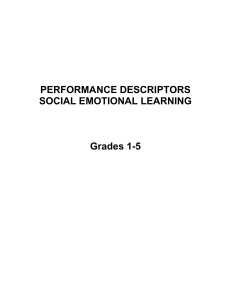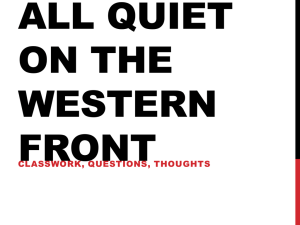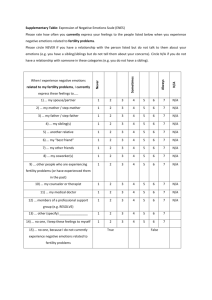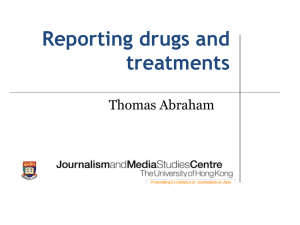Performance Descriptors for Social Emotional Learning, Grades 1-5
advertisement
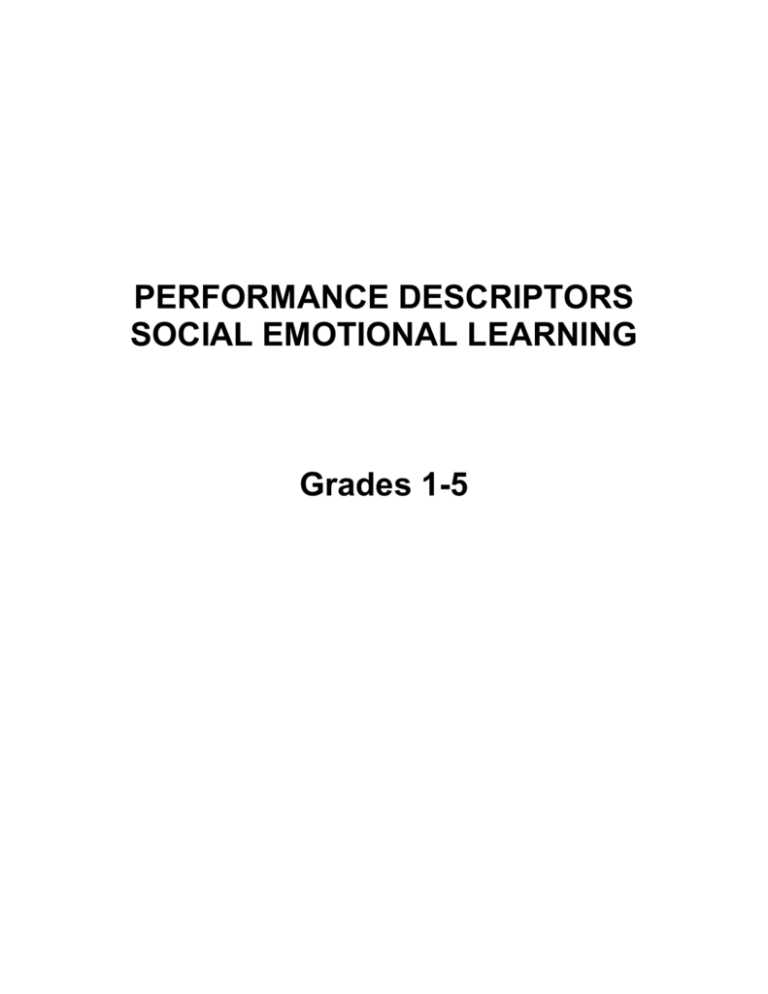
PERFORMANCE DESCRIPTORS SOCIAL EMOTIONAL LEARNING Grades 1-5 Social Emotional Learning Performance Descriptors 1A Identify and manage one’s emotions and behavior. Stage A Stage B Stage C 1. Identify emotions (e.g., happy, surprised, sad, angry, proud, afraid) expressed in “feeling faces” or photographs. 2. Name the emotions felt by characters in stories. 3. Identify ways to calm yourself. 4. Describe a time you felt the same way a story character felt. 5. Discuss classroom and school rules. 6. Share feelings (e.g., through speaking, writing, drawing) in a range of contexts. 1. Describe how various situations make you feel. 2. Describe your physical responses to strong emotions. 3. Recognize that feelings change throughout the day. 4. Demonstrate patience in a variety of situations. 5. Demonstrate a range of emotions through facial expressions and body language. 6. Practice self talk to calm yourself. 1. Identify a range of emotions you have experienced. 2. Describe situations that trigger various emotions (e.g., listening to music, talking to a friend, taking a test, being scolded). 3. Recognize mood changes and factors that contribute to them. 4. Depict a range of emotions (e.g., make a poster, draw a picture, participate in a role play). 5. Distinguish among intensity levels of an emotion. 6. Demonstrate ways to deal with upsetting emotions (e.g., sadness, anger, disappointment). 7. Practice deep breathing to calm yourself. Grade 1 (A-B) Grade 2 (A-B-C) Grade 3 (B-C-D) Grade 4 (C-D-E) Grade 5 (D-E-F) Social Emotional Learning Performance Descriptors 1A Identify and manage one’s emotions and behavior. Stage D 1. 2. 3. 4. 5. 6. 7. List positive strategies for handling conflict. Explain why characters in stories felt as they did. Distinguish among emotions you might feel in various situations. Use “I-statements” to express various emotions. Record changes in your emotions throughout the day (e.g., before and after transitions, recess lunch, etc.). Demonstrate an awareness of how your behavior affects others. Practice different strategies for handling upsetting situations. Grade 1 (A-B) Stage E Stage F 1. Describe the physical responses common to a range of emotions. 2. Describe emotions associated with personal experiences. 3. Practice expressing positive feelings about others. 4. Evaluate ways of dealing with upsetting situations (e.g., being left out, losing, rejection, being teased). 5. Demonstrate emotions in various contexts in role-plays. 6. Practice handling pressure situations (e.g., taking a test, participating in a competitive activity). 1. Identify factors that cause stress both positive and negative. 2. Identify physical reactions to stress (e.g., increased energy and alertness, increased heart rate and respiration, sweaty palms, red face, etc.). 3. Recognize emotional reactions to stress. 4. Describe strategies for dealing with upsetting situations (e.g., disappointment, loss, separation). 5. Reflect on the possible consequences before expressing an emotion. 6. Use “I-statements” to describe how you feel, why you feel that way, and what you might like to change. 7. Practice strategies to reduce stress (e.g., talking to a friend or trusted adult, considering what led to these feelings, physical exercise). Grade 2 (A-B-C) Grade 3 (B-C-D) Grade 4 (C-D-E) Grade 5 (D-E-F) Social Emotional Learning Performance Descriptors 1B Recognize personal qualities and external supports. Stage A Stage B Stage C 1. Identify things you like to do. 2. Identify the values that help you make good choices. 3. Identify the people who can give you the help you need. 4. Describe things you do well. 5. Identify reliable adults from whom you would seek help in an emergency. 6. Describe situations in which you feel confident. 7. Describe situations in which you feel you need help. 8. Demonstrate a special skill or talent you have. 1. Identify the personal traits of characters in stories. 2. Describe an achievement that makes you feel proud. 3. Identify a community resource you enjoy using (e.g., play field, park, swimming pool, etc.). 4. Identify various helpers in the school community. 5. Analyze how you might have done better in a situation. 6. Draw a picture of one of your favorite things to do with others (e.g., play a sport, ride your bike, go to the beach). 1. Identify community members that can be of support when needed (e.g., religious leader, extended family member, and neighbor). 2. Describe the personal qualities that successful learners demonstrate (e.g., perseverance, responsibility, attention to task, etc.). 3. Explain how practice improves your performance of a skill. 4. Analyze the positive qualities of role models. 5. Analyze what it is about school that is challenging for you. 6. Draw a picture of an activity your family likes to do together. 7. Demonstrate ways to ask for help when needed. Grade 1 (A-B) Grade 2 (A-B-C) Grade 3 (B-C-D) Grade 4 (C-D-E) Grade 5 (D-E-F) Social Emotional Learning Performance Descriptors 1B Recognize personal qualities and external supports. Stage D 1 2 3 4 5 6 Identify something you would like to be able to do better. Describe ways in which you contribute to the school community. Describe ways in which you help out at home. List ways families can support students in school. Describe how peers can support each other in school. Measure your progress toward a personal goal. Grade 1 (A-B) Stage E Stage F 1. Describe a time and situation you needed help. 2. Identify reliable adults from whom you would seek help in various situations. 3. Describe how you would improve your ability to perform a valued skill. 4. Explain how adult role models influence your aspirations for the future. 5. Practice strategies that support peers in school. 6. Demonstrate leadership within the school community (e.g., reading tutor, student council, clubs, mentoring new students). 1. Name community resources that promote student success. 2. Identify personal strengths and weaknesses and the effect they have on your choices. 3. Identify physical and emotional changes during adolescence. 4. Recognize that students learn differently. 5. Describe how adults at school demonstrate caring and concern for students. 6. Describe how adults at school demonstrate caring and concern for students. 7. Analyze the effort your family or other adults have made to support your success in school. Grade 2 (A-B-C) Grade 3 (B-C-D) Grade 4 (C-D-E) Grade 5 (D-E-F) Social Emotional Learning Performance Descriptors 1C Demonstrate skills related to achieving personal and academic goals. Stage A 1. 2. 3. 4. 5. 6. Recognize the relationship between what you want to accomplish and setting goals. Explain the various aspects of being successful in school. Describe a behavior you would like to change. Give an example of an academic goal you could set for yourself. Give an example of a personal goal you could set for yourself. Divide a goal you have set into manageable steps. Grade 1 (A-B) Stage B Stage C 1. Identify a situation you want to change. 2. Identify the progress that you have made toward achieving your goal. 3. Explain the relationship between success in school and becoming what you want to be. 4. Describe how you might improve your classroom behavior (e.g., raise your hand more often, complete assignments, pay attention). 5. Make a plan for how to improve your performance in a school subject. 6. Make a plan for how to achieve a personal goal. 7. Use self-talk to reward yourself for accomplishments. 1. Recognize how distractions may interfere with achievement of a goal. 2. Recognize that present goals build on the achievement of past goals. 3. Describe the steps you have made toward achieving a goal. 4. Differentiate between short and long term goals. 5. Monitor your progress toward achieving a personal or academic goal. 6. Demonstrate ways to deal with upsetting emotions (e.g., sadness, anger, disappointment). Grade 2 (A-B-C) Grade 3 (B-C-D) Grade 4 (C-D-E) Grade 5 (D-E-F) Social Emotional Learning Performance Descriptors 1C Demonstrate skills related to achieving personal and academic goals. Stage D Stage E Stage F 1. Identify how obstacles have been overcome in achieving a goal (e.g., examples from literature, social science, personal experience). 2. Recognize how conditions and people have contributed to your achievement of a goal. 3. Identify the steps needed to perform a routine task (e.g., homework completion, organization of personal space/materials, studying for a test). 4. Identify factors you could not change that prevented you from achieving a recent goal. 5. Evaluate what you might have done differently to achieve greater success on a recent goal. 1. Develop a friendship goal with action steps to be taken by certain dates. 2. Develop an academic goal with action steps to be taken by certain dates. 3. Monitor progress on planned action steps for a friendship goal. 4. Monitor progress on planned action steps for an academic goal. 5. Analyze why you needed to change or delay action steps for achieving a recent goal. 6. Evaluate your level of achievement with regard to a recent goal. 1. Set a goal that you could expect to achieve in a month or two to improve some aspect of your school performance. 2. Identify obstacles to achievement of your goal. 3. Brainstorm possible ways to overcome obstacles in achieving your goals. 4. Make a plan with action steps and timeframes to achieve your goal. 5. Monitor progress on your goal. 6. Evaluate your success and analyze what you might have done differently. Grade 1 (A-B) Grade 2 (A-B-C) Grade 3 (B-C-D) Grade 4 (C-D-E) Grade 5 (D-E-F) Social Emotional Learning Performance Descriptors 2A Recognize the feelings and perspectives of others. Stage A Stage B Stage C 1. Recognize that others may interpret the same situation differently from you. 2. Recognize that others may feel differently from you about the same situation. 3. Describe how others are feeling based on their facial expressions and gestures. 4. Explain how interrupting others may make them feel. 5. Explain how sharing with and supporting others may make them feel. 6. Recognize how changing your behaviors can impact how others feel and respond. 1. Identify verbal, physical, and situational cues in stories. 2. Recognize the value of sharing diverse perspectives. 3. Explain why characters in stories feel as they do. 4. Analyze how students being left out might feel. 5. Describe how different people interpret the same situation. 6. Demonstrate an ability to listen to others (e.g., making eye contact, nodding, asking clarifying questions). 1. Distinguish between nonverbal and verbal cues and messages. 2. Analyze alignment and non-alignment of verbal and non-verbal cues. 3. Role-play the perspectives and feelings of characters from a story. 4. Paraphrase what someone has said. 5. Demonstrate a capacity to care about the feelings of others. 6. Demonstrate an interest in the perspective of others. Grade 1 (A-B) Grade 2 (A-B-C) Grade 3 (B-C-D) Grade 4 (C-D-E) Grade 5 (D-E-F) Social Emotional Learning Performance Descriptors 2A Recognize the feelings and perspectives of others. Stage D 1. 2. 3. 4. 5. 6. Label others’ feelings based on verbal and non-verbal cues in different situations. List strategies to support students who are left out or bullied. Describe how one feels when left out of an activity or group. Describe how one feels when bullied. Predict possible responses to a range of emotions. Use “I-statements” to let others know that you have heard them. Grade 1 (A-B) Stage E Stage F 1. Describe others’ feelings in a variety of situations. 2. Describe an argument you had with another person and summarize both points of view. 3. Analyze why literary characters felt as they did. 4. Analyze the various points of view expressed on an historical, political, or social issue. 5. Evaluate how a change in behavior of one side of a disagreement affects the other side. 1. Identify and practice reflective listening skills through discussion and role-play. 2. Recognize how a situation would make you feel and treat others accordingly. 3. Describe others’ feelings in a variety of situations. 4. Ask open-ended questions to encourage others to express themselves. 5. Use follow-up questions to clarify messages. 6. Predict how one’s own behavior might affect the feelings of others. 7. Interpret non-verbal communication cues. Grade 2 (A-B-C) Grade 3 (B-C-D) Grade 4 (C-D-E) Grade 5 (D-E-F) Social Emotional Learning Performance Descriptors 2B Recognize individual and group similarities and differences. Stage A 1. Identify examples of classroom behavior that are sensitive to the needs of others (e.g., taking turns, listening to one another, supporting each other’s ideas). 2. Recognize that all people are similar in the needs they share. 3. Participate in the development of classroom rules. 4. Describe rules that help students treat each other fairly. 5. Demonstrate how students help each other (e.g., sharing, not interrupting). 6. Demonstrate honesty and fairness while playing or working with others. Stage B 1. 2. 3. 4. 5. 6. Grade 1 (A-B) Grade 2 (A-B-C) Stage C Recognize the existence of various groups based on social and cultural variables (e.g., age, race, ethnicity, shared interests, religion, and disability). Describe what one has learned about the ways cultural groups differ from one another (e.g., holidays, foods, music, and customs). Recognize that people who share a cultural tradition differ from one another in other ways. Recognize how diversity enriches a community. Compare and contrast various family structures. Reflect on your experiences with people of different age groups. Grade 3 (B-C-D) 1. Describe human differences depicted in stories. 2. Describe how interactions with individuals from different cultures enrich one’s life. 3. Recognize that people from different cultural and social groups share many things in common. 4. Analyze how people of different groups can help one another and enjoy each other’s company. 5. Analyze the impact of differing responses to human diversity on literary characters. 6. Participate in an activity or simulation that allows you to experience life from the perspective of another group. 7. Use literature to analyze various responses to human diversity (e.g., learning from, being tolerant of, aware of stereotyping). Grade 4 (C-D-E) Grade 5 (D-E-F) Social Emotional Learning Performance Descriptors 2B Recognize individual and group similarities and differences. Stage D Stage E Stage F 1. Recognize the different social groups in school. 2. Recognize the different cultural groups in school. 3. Compare and contrast social groups. 4. Compare and contrast cultural groups. 5. Analyze the unique contributions of individuals and groups as featured in biographies, legends, and folklore. 6. Develop strategies for building relationships with others who are different from oneself. 1. Describe the basic rights of all individuals regardless of their social or cultural affiliations. 2. Describe examples of how the media portray various social and cultural groups. 3. Analyze how responsible students help their classmates. 4. Demonstrate strategies for building relationships with others who are different from oneself. 5. Design a project that shows how your class or school is enriched by different cultures. 1. Identify unwelcome teasing or bullying behaviors. 2. Identify ways to overcome misunderstanding among various social and cultural groups. 3. Identify ways to advocate for others. 4. Describe situations where minority groups have been respected at school or in the community. 5. Discuss stereotyping and its negative impact on others. 6. Demonstrate respect for members of various ethnic and religious groups. Grade 1 (A-B) Grade 2 (A-B-C) Grade 3 (B-C-D) Grade 4 (C-D-E) Grade 5 (D-E-F) Social Emotional Learning Performance Descriptors 2C Use communication and social skills to interact effectively with others. Stage A Stage B Stage C 1. Describe appropriate ways to seek group entry. 2. Use “please” and “thank you” appropriately. 3. Raise one’s hand for recognition. 4. Pay attention when someone else is speaking. 5. Follow directions given at school. 6. Take turns and share toys and other resources with classmates. 7. Practice sharing encouraging comments with others. 8. Practice saying “no” to protect yourself from unsafe situations. 1. Discuss ways of initiating contact with someone you don’t know. 2. Discuss how to be a good friend. 3. Greet others by name. 4. Make and respond appropriately to introductions. 5. Summarize a plan for making friends. 6. Use appropriate nonverbal communication with others (e.g., movements, gestures, posture, facial expressions). 7. Participate in establishing and enforcing ground rules for class and group/team efforts. 1. Recognize when it is appropriate to give a compliment. 2. Practice introducing everyone in your class. 3. Demonstrate how to give a compliment. 4. Demonstrate appropriate responses to receiving a compliment. 5. Use ’I-statements” to express how you feel when someone has hurt you emotionally. 6. Demonstrate expressing appreciation to someone who has helped you. Grade 1 (A-B) Grade 2 (A-B-C) Grade 3 (B-C-D) Grade 4 (C-D-E) Grade 5 (D-E-F) Social Emotional Learning Performance Descriptors 2C Use communication and social skills to interact effectively with others. Stage D Stage E Stage F 1. Identify ways to build positive relationships with peers, family and others. 2. Identify attributes of cooperative behavior in a group setting. 3. Demonstrate cooperative behaviors in a group. 4. Practice reflective listening (e.g., I messages, paraphrase). 5. Demonstrate how to initiate conversation with a new student. 6. Develop a plan that supports the improvement of behaviors within a group. 1. Describe the qualities of an effective communicator. 2. Respond positively to constructive criticism. 3. Take responsibility for one’s mistakes. 4. Interview an adult on the topic of how to develop friendships. 5. Demonstrate support for others’ contributions to a group/team effort. 6. Distinguish between positive and negative peer pressure. 7. Demonstrate strategies for resisting negative peer pressure. 1. Recognize the difference between positive and negative relationships. 2. Describe ways to express forgiveness. 3. Practice reflective listening. 4. Respond nondefensively to criticism or accusation through role-play. 5. Demonstrate encouragement of others and recognition or their contributions. 6. Demonstrate graciousness in winning and losing. 7. Practice turning criticism into constructive feedback. Grade 1 (A-B) Grade 2 (A-B-C) Grade 3 (B-C-D) Grade 4 (C-D-E) Grade 5 (D-E-F) Social Emotional Learning Performance Descriptors 2D Demonstrate an ability to prevent, manage, and resolve interpersonal conflicts in constructive ways. Stage A Stage B 1. Describe situations at school in which classmates might disagree and experience conflict (e.g. refusing to share supplies, not apologizing for hurt feelings, making false accusations, excluding someone from an activity). 2. Describe situations in the home where children and parents might disagree and experience conflict (e.g., resisting the enforcement of rules or completing of household chores). 3. Describe a time when you had a disagreement with someone, what happened, and how you might have handled the situation differently. 4. Distinguish between constructive and destructive ways of resolving conflict. 5. Use puppets to act out and resolve conflict situations. 6. Practice self-calming techniques for anger management as a way to de-escalate conflict situations. 1. Recognize various methods of resolving conflict. 2. Explain what a rumor is and how it hurts others. 3. Identify ways of refusing negative peer pressure. 4. Explain how conflict can turn to violence. 5. Analyze how misunderstanding what someone said or did could cause conflict. 6. Analyze how falsely accusing someone of something or being intolerant of their behavior could cause conflict. Grade 1 (A-B) Grade 2 (A-B-C) Grade 3 (B-C-D) Stage C 1. Identify bullying behavior and how it affects people. 2. Explain what happens when a conflict is not resolved. 3. Describe ways to stop rumors. 4. Analyze how an inability to manage one’s anger might cause a conflict to get worse. 5. Interpret whether the actions of literary characters were accidental or intentional. 6. Examine how one’s favorite literary character handles conflict. Grade 4 (C-D-E) Grade 5 (D-E-F) Social Emotional Learning Performance Descriptors 2D Demonstrate an ability to prevent, manage, and resolve interpersonal conflicts in constructive ways. Stage D 1. Identify the consequences of a solution. 2. Identify assertive, passive and aggressive conflict resolution behaviors. 3. Describe conflicts you have experienced and how you dealt with them. 4. Explain how resolving a conflict with a friend could strengthen the friendship. 5. Generate alternative solutions for a conflict. 6. Demonstrate constructive conflict resolution strategies in the classroom. Grade 1 (A-B) Grade 2 (A-B-C) Stage E Stage F 1. Identify the consequences of conflict resolution behavior. 2. Identify refusal skills for unsafe behaviors (e.g., drugs and alcohol, gang involvement, and sexual activity). 3. Explain how resolving a conflict could improve one’s understanding of a situation. 4. Distinguish between positive and negative peer pressure. 5. Demonstrate resisting peer pressure to do something unsafe or potentially dangerous. 6. Use a checklist to practice the steps of refusing unwanted peer pressure. 1. Recognize that conflict is a natural part of life. 2. Identify intervention strategies to stop bullying. 3. Suggest ways of addressing personal grievances to avoid conflict. 4. Analyze different approaches to dealing with conflict (e.g., avoidance, compliance, negotiation). 5. Analyze why you may have to use different strategies for dealing with different conflict situations. 6. Evaluate ways to include every one in group activities. 7. Use verbal and nonverbal strategies to resolve group conflict. Grade 3 (B-C-D) Grade 4 (C-D-E) Grade 5 (D-E-F) Social Emotional Learning Performance Descriptors 3A Consider ethical, safety, and societal factors in making decisions. Stage A Stage B Stage C 1. Identify and follow bus, classroom, and school safety rules. 2. Recognize appropriate touch; and avoid inappropriate touch. 3. Explain how taking or destroying another’s property makes them feel. 4. Explain why hitting or yelling at somebody is hurtful and unfair. 5. Identify reliable sources of adult help. 6. Describe situations when you might feel unsafe and need help (e.g., crossing a busy street, being approached by a strange adult). 7. Draw pictures of ways to help others. 1. Identify personal behaviors that are dangerous. (e.g., riding a bike without a helmet, riding with someone who has been drinking, accepting a ride from someone you don’t know). 2. Explain why it is important to treat others as you would want to be treated. 3. Analyze how rules your family uses help its members get along together. 4. Contribute to school safety by supporting classroom, lunchroom and playground rules. 5. Participate in creating and enforcing classroom rules. 6. Demonstrate sharing and taking turns. 1. Identify examples of ethical behavior by characters in stories (e.g., fairness, honesty, respect, compassion). 2. Identify physical sensations and emotions that indicate a threat or danger. 3. Describe the consequences of breaking classroom or school rules. 4. Analyze the consequences of lying. 5. Depict ways to help others (e.g., list, draw, cartoons). 6. Evaluate various approaches to responding to provocation. 7. Decide what is fair in responding to situations that arise in the classroom (e.g., how to share a new piece of equipment). Grade 1 (A-B) Grade 2 (A-B-C) Grade 3 (B-C-D) Grade 4 (C-D-E) Grade 5 (D-E-F) Social Emotional Learning Performance Descriptors 3A Consider ethical, safety, and societal factors in making decisions. Stage D 1. Identify factors that 2. 3. 4. 5. 6. 7. make a situation unsafe. Recognize the consequences to oneself and others of dishonest behavior. Evaluate how others influenced your decisions (e.g., family, church, team, club membership). Avoid dangerous situations (e.g., unsupervised sports, walking in areas where you feel unsafe, biking without a helmet, hanging around with peers who use drugs). Demonstrate respect for the property of others. Demonstrate internet safety. Show what it means to accept responsibility for one’s actions with regard to school work. Grade 1 (A-B) Stage E Stage F 1. Describe how differing points of view affect your decision-making process. 2. Describe what it means to be dependable and why this is sometimes difficult (e.g., meeting deadlines, keeping commitments). 3. Explain why it is important to obey laws. 4. Analyze what it means to be responsible with regard to one’s family, friends, school community. 5. Evaluate conflicting points of view in making a decision. 1. Recognize that an individual is responsible for his/her behavior. 2. Identify the need for rules at school, home, and in society. 3. Analyze what it means to be responsible for one’s health. 4. Analyze the needs of others in planning how work or sharing goods should be divided (e.g., those with handicaps, those who are disadvantaged, and those with special abilities). 5. Analyze the risks of potentially dangerous situations. 6. Develop strategies to work things out rather than retaliate when you feel wronged. Grade 2 (A-B-C) Grade 3 (B-C-D) Grade 4 (C-D-E) Grade 5 (D-E-F) Social Emotional Learning Performance Descriptors 3B Apply decision-making skills to deal responsibly with daily academic and social situations. Stage A Stage B Stage C 1. Recognize that one has choices in how to respond to situations. 2. Describe calming strategies. 3. Brainstorm alternative solutions to problems posed in stories and cartoons. 4. Use “I-statements” in expressing feelings. 5. Implement stop, think, and act (plan) strategies in solving problems. 6. Practice group decision making with one’s peers in class meetings. 7. Identify foods and behaviors that keep the body healthy. 1. Describe the use of selftalk to calm down. 2. Brainstorm alternative solutions to interpersonal problems in the classroom. 3. Analyze how your tone of voice influences how others respond to you. 4. Analyze the consequences of alternative choices. 5. Make healthy choices regarding snacks. 6. Demonstrate reflective listening. 7. Demonstrate wise decisions regarding safety hazards (e.g., wearing seat belts in cars, wearing a bicycle helmet; avoiding sharp objects, too much sun exposure, and playing with fire). 1. Describe ways to promote the safety of oneself and others. 2. Describe the steps of a decision-making model. 3. Brainstorm alternative solutions to completing an assignment on time. 4. Practice progressive relaxation. 5. Demonstrate wise choices in selecting friends. 6. Demonstrate group decision making. 7. Plan healthy meals. Grade 1 (A-B) Grade 2 (A-B-C) Grade 3 (B-C-D) Grade 4 (C-D-E) Grade 5 (D-E-F) Social Emotional Learning Performance Descriptors 3B Apply decision-making skills to deal responsibly with daily academic and social situations. Stage D 1. Generate alternative solutions to problems. 2. Analyze the consequences of alternative solutions to selected scenarios. 3. Develop criteria for evaluating the consequences of a decision for oneself and important others in one’s life. 4. Demonstrate the steps of a decision-making process: o define the problem o say how you feel o identify contributing factors o set a goal o identify alternative solutions and the consequences of each o select the best solution o evaluate the results. 5. Apply a decisionmaking model to solve an interpersonal problem. 6. Apply a decisionmaking model to academic challenges. 7. Demonstrate awareness that feelings influence one’s decisions. Grade 1 (A-B) Stage E 1. 2. 3. 4. 5. Grade 2 (A-B-C) Stage F Identify challenges and obstacles to solving problems. Identify healthy alternatives to risky behaviors. Evaluate strategies to promote school success (e.g., identifying distractions, managing stress, and putting first things first). Practice aligning nonverbal and verbal communication in refusing unwanted behavior. Apply a decisionmaking model to deal with unwanted behavior. Grade 3 (B-C-D) 1. Identify tools to manage time better. 2. Evaluate strategies for avoiding risky behavior (e.g., avoiding risky situations, ignoring negative peer pressure, suggesting alternative activities, and pointing out unacceptable consequences). 3. Use a homework organizer. 4. Demonstrate an ability to set priorities. 5. Demonstrate an ability to stay on task 6. Demonstrate an ability to complete assignments on time. Grade 4 (C-D-E) Grade 5 (D-E-F) Social Emotional Learning Performance Descriptors 3C Contribute to the well-being of one’s school and community. Stage A Stage B Stage C 1. Identify how you currently help out at home and what else you might do for a caregiver or sibling. 2. List ways that students can help their class run more smoothly. 3. Express how you feel about helping out in class or at home. 4. Describe what you learned about yourself in helping out in class and at home. 5. Volunteer for various classroom tasks (e.g., helping with room set up, cleaning up, passing out papers, etc.). 6. Participate in making and enforcing class rules. 1. Identify a way you can help improve your local community. 2. Describe what you have done to make a positive difference in your class or school and how this made you feel. 3. Brainstorm ways to help your teacher address a shared concern. 4. Volunteer to help out at home in a way that goes beyond what you are expected to do. 5. Participate in developing a class policy on teasing. 6. Plan and implement a project to improve your local community. 1. Describe what you learned about your school or community from your participation in a recent service project 2. Describe what you learned about yourself from participation in this project. 3. Analyze the impact on the need addressed of a recent service project in which you participated. 4. Analyze what you would do differently next time. 5. Communicate the results of a school or community service project to a parent or community group. 6. Write a letter to a newspaper editor on a community problem such as homelessness. Grade 1 (A-B) Grade 2 (A-B-C) Grade 3 (B-C-D) Grade 4 (C-D-E) Grade 5 (D-E-F) Social Emotional Learning Performance Descriptors 3C Contribute to the well-being of one’s school and community. Stage D 1. Identify ways that community workers assist residents in protecting and improving neighborhoods. 2. Analyze your rights and responsibilities as a member of your school community. 3. Discuss your reasons for voting as you did in a simulated local, state, or national election. 4. Participate in making and enforcing classroom rules. 5. Brainstorm ways you could contribute to your community (e.g., help a neighbor, contribute to community safety, help keep your block clean). 6. Construct an argument to persuade classmates to vote or become a candidate for office in a simulated local, state, and national election. Grade 1 (A-B) Stage E 1. 2. 3. 4. 5. 6. Grade 2 (A-B-C) Stage F Identify various ways that community workers assist residents in beautifying and protecting neighborhoods. Gather information on a community issue or need. Develop a plan with your classmates to address a community issue or need. Monitor your progress on implementing a plan to address a community issue or need. Evaluate implementation of a class plan to address a community issue. Make recommendations on how you would improve a plan that addresses a community issue. Grade 3 (B-C-D) 1. Work with other students to plan and implement a service project in your school. 2. Describe ways of showing respect for your school environment. 3. Support activities of various groups in your school. 4. Contribute in positive ways to your home environment. 5. Describe the role of a community service worker. 6. Plan and implement with other students a service project in your community. 7. Plan a field trip to a community agency. Grade 4 (C-D-E) Grade 5 (D-E-F)
